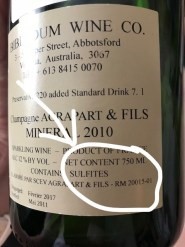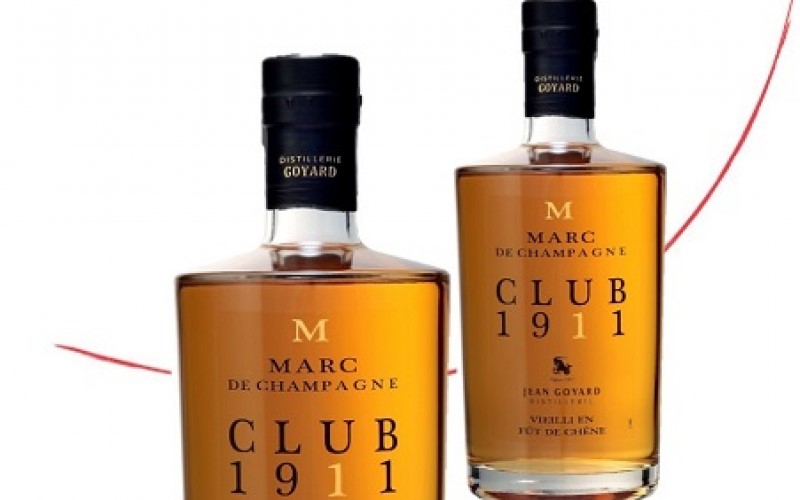
The Three Main Types Of Champagne Producers
- Marnie Nichols
- October 6, 2018
- Blog, Champagne School, Video Posts
There are three main types of champagne producers.
- Houses (or Grandes Marques or Great Brands) – defined as purchasing the majority of the grapes, grape must, or wine to make their champagne.
- Growers – required to make champagne exclusively from their own grapes
- Cooperatives – who sell wines made from their members’ grapes.
Houses (NM – négociant manipulant)
You can identify if a champagne is produced by a house by looking (very closely because the type is TINY!) at the label. NM (négociant manipulant) will appear beside the producer’s name, indicating the producer purchases the majority of the grapes, grape must or wine to make their champagne. You may need a magnifying glass to find the letters, but it will be there, generally on the front label.

There are 380 houses who dominate sales and account for 2/3s of all champagne shipments, but they only own about 10% of all the vineyards in France. You’ll know some names – GH Mumm, Moet, Veuve – but not all of them because not all of them are exported.
Houses can be corporately owned (for example Moet & Chandon and Veuve Clicquot are owned by LVMH), or family-owned and operated (like Taittinger, Billecart-Salmon and Philipponnat). And NM or houses may not all be big producers… Philipponnat only produces about 600,000 bottles a year.
Growers (RM – récoltant manipulant)
You can identify if a champagne is produced by a grower by the label. RM – récoltant manipulant, a grower who makes champagne exclusively from their own grapes.

There are more than 15,000 growers in Champagne and between them they own roughly 90% of the vineyards. About 2,000 of these growers choose to make and market their own champagne.
There will be many names you will probably never have heard of registered as RM like Agarapart & Fils in this example. Recently, some well-known grower champagnes, for example Bereche & Fils and Laherte Freres, have actually registered as NM so they can buy more grapes to increase the diversity of grapes they can use in their wines.
Cooperatives (CM – Coopérative de Manipulation)
You can identify if a champagne is produced by a co-op by the label. CM – Coopérative de Manipulation, a cooperative that sells wines from its members’ grapes.

Cooperatives are smaller in number and represent groups of growers who pool their resources – grapes, production facilities and marketing – to sell under a single label.
Nicolas Feuillatte is the oldest and largest example of a co-op, other examples are Mailly Grand Cru (this example), and Devaux.
Other types of producers
A variation of the grower and co-op is the designation RC – récoltant co-opérateur, someone who’s a member of a co-op and buys back wine from them to sell under their own label.
SR – Société de Récoltants – represents a group of growers, usually family members, who make champagne from their own vineyards.
ND – Négociant Distributeur – a merchant who buys bottles of champagne and sells them under their own label.
MA – Marque d’Acheteur – for a buyer’s own brand. For example, this could be labels created specifically for another brand like a supermarket or liquor store, like Duperrey (see below) which you can get from BWS and Dan Murphy’s in Australia but is made by GH Martel & Co.

What does it all mean and what’s better?
Houses and growers and co-ops can all make lovely, exciting, and brilliant champagne. I have tried and loved champagnes from them all.
Like any wine-making region, some winemakers produce amazing and high-quality wines… and others don’t.
The key differences for me are…
Champagne Houses…
Have the advantage of access to higher quantities and diversity of grapes from more diverse terroir because they aren’t restricted to using just their own grapes.
And the larger champagne houses produce enough wine every year to enable them to hold back reserve wines to use in blending their NVs to achieve the consistent taste and house style.
But it is worth noting that for some houses (not all) to buy enough volume of grape juice to produce the amount of champagne they want to produce, they are often buying the second pressing from a smaller house or grower who chooses NOT to include the juice from the second press in their champagnes because it is not the quality they want for their own champagnes (#justsaying). (If you are interested, you can read this post for a guide to the volumes produced by big houses).
Growers usually don’t have access to the same quantity of grapes to produce their champagnes, making it a much harder decision (or totally impossible) for them to hold back reserve wines for blending. They often have to use all their wine every year to meet the year’s production needs. This can mean their champagnes seem less consistent but if you look at it from their way of thinking, they don’t want “same same” every year. That’s not what their style of champagne is about. They WANT each year to be different and expressive of the prevailing conditions that season.
And speaking of weather conditions, another advantage the champagne houses have is they have a bit more insurance in years when specific areas are hit with really bad weather. If a grower’s vineyards are hit with bad weather and crops are wiped out by disease, it can have a devastating impact on production. But houses can just source grapes from an area not affected or not as badly affected.
Consumers have come to expect the blended/house style which has been the benchmark for so long. Especially in Australia where what we drink is 96% houses and 90% NV!
Grower champagnes…
But because growers are restricted to using their own grapes, from their smaller vineyards, their wines generally have a really specific terroir. And it has created an opportunity for growers to work their angle… it makes their wines unique and – in my opinion – bloody exciting! Read more here – Grower Champagnes… just hype or seriously hot?
And so grower champagnes have become the champions of terroir and ‘terroir expressive champagnes’. This means champagnes that aren’t blended to taste the same all the time. They are more distinct and the characteristics of the grapes from that area come through more prominently in the wine.
There is an incredible book by Peter Liem, called Champagne, in which he writes in great detail about Champagne and terroir. He actually spends 320 fascinating pages talking about terroir (which as a champagne nerd, I love!).
Peter Liem describes it like this… the difference between blended champagnes and grower champagnes is like the difference between listening to a symphony orchestra (which he likens to blended champagnes or houses) and a soloist (which is the grower and more terroir-specific). Both are incredible but you may prefer one style over the other.
I would say grower champagnes are more honest and pure. Or it’s like having a cocktail or vodka on the rocks. A single malt or blended whisky. So, it’s not really new… it’s a concept we actually see every day.
With more emphasis on terroir (aka climate, dirt/soil and terrain), it’s not surprising we are seeing more sustainable and organic viticulture and low and zero dosage champagnes from growers – all elements that allow you to taste the terroir… or in wine vocab, the terroir to be ‘expressed’.
And the champagnes they are producing are amazing. Now I have ‘grown up’ on the house styles and have fallen in love with champagne studying their wines… and I am fully embracing and enjoying grower champagnes too. I can really recognise the difference. And seriously… if I can smell and taste how they are different, anyone can!
Don’t make the mistake of thinking houses all produce high-volume commercial rubbish wines… that is just not the case.
And don’t fall into a trap of thinking all grower champagnes must be amazing… because they aren’t always.
There is no way to judge a wine based on the status of grower Vs house and if you apply blanket rules, you’re an idiot because you will miss out on some awesome champs.
But hopefully after taking all this in, you will be a bit more aware of the differences and take a look at the labels of what you’re drinking.
As always, I want to know what you are drinking and thinking… so if you’re tasting it, post a pic and tag @bubbleandflute #bubbleandflute on facebook or instagram.
Santé
Marnie
Catch my video on the subject here...
More from Champagne School...
Champagne Villages And The Cru System
Regions Within Champagne
What Grapes Are Used To Make Champagne?
Does Size Matter? A Guide To Champagne Bottle Sizes (Just To Be Clear!)
After The Harvest… The Process For Champagne Pressing
Champagne Spirits – Marc De Champagne, Fine De La Marne, And Chardonnay Vodka
Ratafia De Champagne
Rosé Des Riceys… A Still Rosé Wine They Make In Champagne
Coteaux Champenois… Still Wines Made In Champagne
The Oeil De Perdrix… A Special Kind Of Rosé Champagne
Bubble & Flute promotes the responsible consumption of alcohol for individuals of legal drinking age in their country.


















